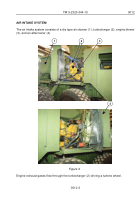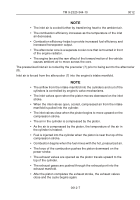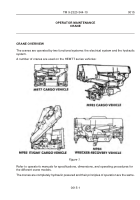TM-9-2320-344-10 - Page 133 of 1012
NOTE
•
The inlet air is cooled further by transferring heat to the ambient air.
•
The combustion efficiency increases as the temperature of the inlet
air decreases.
•
Combustion efficiency helps to provide increased fuel efficiency and
increased horsepower output.
•
The aftercooler core is a separate cooler core that is mounted in front
of the engine radiator.
•
The engine fan and the ram effect of the forward motion of the vehicle
causes ambient air to move across the core.
The pressurized inlet air is cooled by the precooler (7) prior to being sent to the aftercooler
(8).
Inlet air is forced from the aftercooler (7) into the engine's intake manifold.
NOTE
•
The airflow from the intake manifold into the cylinders and out of the
cylinders is controlled by engine's valve mechanisms.
•
The inlet valves open when the piston moves downward on the inlet
stroke.
•
When the inlet valves open, cooled, compressed air from the intake
manifold is pulled into the cylinder.
•
The inlet valves close when the piston begins to move upward on the
compression stroke.
•
The air in the cylinder is compressed by the piston.
•
As the air is compressed by the piston, the temperature of the air in
the cylinder is heated.
•
Fuel is injected into the cylinder when the piston is near the top of the
compression stroke.
•
Combustion begins when the fuel mixes with the hot, pressurized air.
•
The force of the combustion pushes the piston downward on the
power stroke.
•
The exhaust valves are opened as the piston travels upward to the
top of the cylinder.
•
The exhaust gases are pushed through the exhaust port into the
exhaust manifold.
•
After the piston completes the exhaust stroke, the exhaust valves
close and the cycle begins again.
TM 9-2320-344-10
0012
0012-7
Back to Top




















